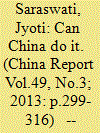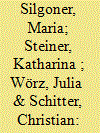|
|
|
Sort Order |
|
|
|
Items / Page
|
|
|
|
|
|
|
| Srl | Item |
| 1 |
ID:
124989


|
|
|
|
|
| Publication |
2013.
|
| Summary/Abstract |
Since the turn of the century the Chinese state has endeavoured to establish an internationally competitive, export-oriented software services industry centred on large domestic firms. However, despite concerted targeting and significant state investment, the industry's size and capabilities have fallen further behind those in peer competitor countries, particularly India. The article assesses the progress of the industry in China and examines how this relates to the PRC's software strategy. It does so by adopting a comparative analysis approach, evaluating the PRC's policy agenda and the axioms underpinning it in light of emerging research on the processes and mechanisms behind the more successful development of the software services industry in India. The article concludes by arguing that the PRC needs to make several substantive changes to its software strategy if it is to achieve its objectives
|
|
|
|
|
|
|
|
|
|
|
|
|
|
|
|
| 2 |
ID:
137536


|
|
|
|
|
| Summary/Abstract |
We investigate the impact of the emergence of China as a global competitor on the trade performance of Central, Eastern and Southeastern European (CESEE) countries at the EU-15 market, i.e. the fifteen EU members as of 1995. The main aim of the paper is thus to challenge the common view that China crowds out exporters from European markets. The paper takes a comprehensive approach in terms of empirical methods and data. We analyze export growth, export market shares, extensive and intensive margins and the dynamics in the number of joint trade links (Dynamic Trade Link Analysis), applying highly disaggregated data at the 6-digit HS level over the period 1995–2010. We show that the most contested markets are those for capital goods and transport equipment, product categories where both regions have gained market shares and comparative advantage. We show that the number of trade links at the product level where both regions are active has increased substantially, indicating intensified competition. At the same time hardly any trade links were lost, which points against cut-throat competition between CESEE and China. The decomposition of export growth along the extensive versus the intensive margin shows that in line with the literature, the deepening of already existing trade relationships (i.e. the intensive margin) contributed most strongly to export growth in both regions, whereas the contribution of new trade links (i.e. the extensive margin) had only a minor contribution, apart from the instance of EU accession, which boosted the extensive margin considerably. We further decompose intensive margin growth into demand related structural effects and a supplier related competitiveness effect. Both the CESEE region and China successfully intensified their trade linkages above all as a result of their outstanding competitiveness as shown by the econometric shift-share analysis. While this suggests that both regions pursue a suitable export strategy, further diversification of production towards promising new industries and markets will become increasingly crucial for both, especially in face of projected slower EU-15 market growth in the longer run.
|
|
|
|
|
|
|
|
|
|
|
|
|
|
|
|
|
|
|
|
|